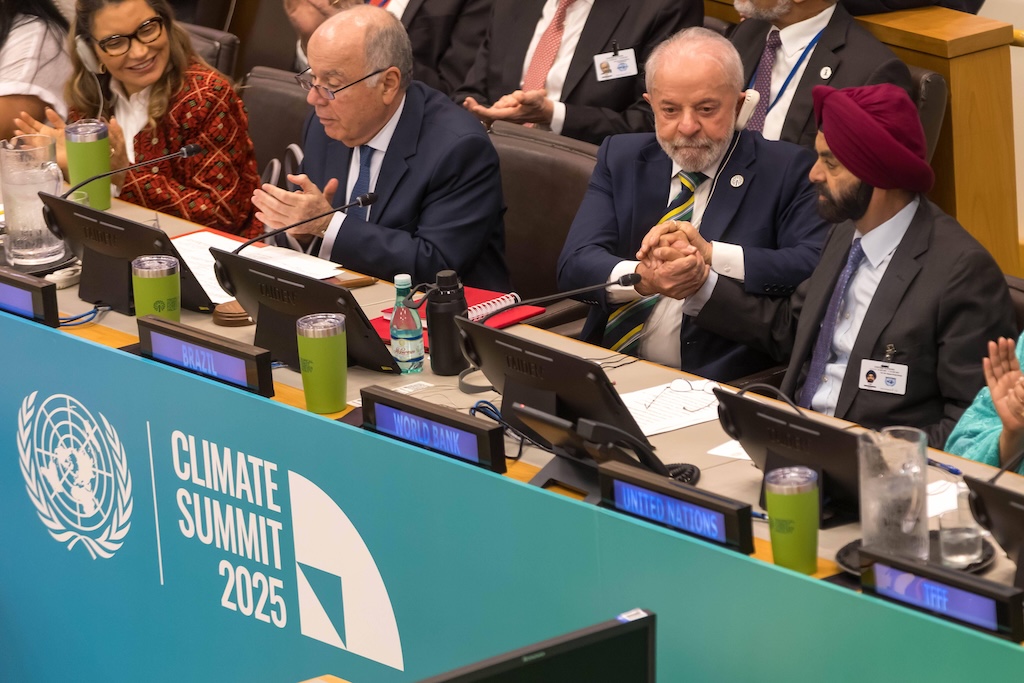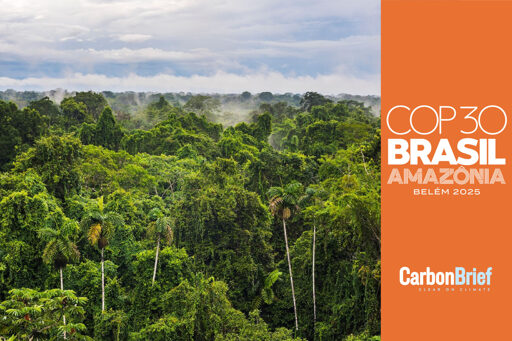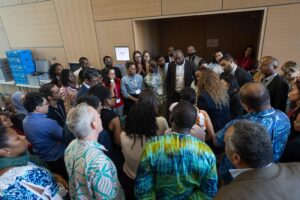Billed as the “Amazon COP”, the UN climate talks will see the debut of Brazil’s flagship fund to “reward” tropical countries for keeping their forests intact.
The Tropical Forest Forever Facility (TFFF) will be launched at the COP30 leaders’ summit on 6 November.
The fund aims to raise and invest $125bn from a range of sources, with excess returns channelled to up to 74 developing countries that sufficiently protect their forests.
This, according to Brazil, would make it one of the biggest multilateral investment funds for nature.
(For comparison, the Green Climate Fund’s portfolio is around $18bn.)
While Brazil expects TFFF to “transform the world’s approach to environmental conservation”, many critics remain unconvinced.
They argue that conservation funding for climate-critical forests should not depend on “betting on stock market prices” and instead call for new biodiversity finance.
Here, Carbon Brief takes a closer look at where the fund came from, how it will be set up and how it is supposed to work.
What is the Tropical Forest Forever Facility?What is it designed to achieve?How will the fund work?What issues might the fund face? Finance fragmentationPotential financial riskCommodification and transparencyLow Indigenous involvement
What is the Tropical Forest Forever Facility?
First officially proposed by Brazil at COP28 in Dubai in 2023, the Tropical Forest Forever Facility aims to pay up to 74 developing tropical forest countries for keeping their existing old-growth forests intact.
It plans to do this by raising $25bn in capital from wealthy “sponsor” governments and philanthropies, which – it hopes – will attract an additional $100bn in private investment.
Returns on these investments will go towards paying back investors and making “forest payments” to countries that increase or maintain their forest cover.
On 4 November, Brazil’s finance minister Fernando Haddad told Bloomberg that “he believed the fund could raise $10bn by next year”, less than half the original target.
While the facility’s official launch is slated for COP30, its rules are still being finalised after several iterations of “concept notes” and consultations.
However, the idea that underpins the fund is not new.
Former World Bank treasurer Kenneth Lay first floated the idea of a Tropical Forest Finance Facility around 15 years ago.
Lay and others later envisioned the TFFF as a “pay-for-performance” sovereign wealth fund for forests. In their design of the TFFF, loans from developed countries and private investors would have been invested in the debt markets of tropical forest countries, with excess returns being allocated annually as “rainforest rewards”.
In their thinking, TFFF offered a “highly-visible, large-scale reward for successfully tackling deforestation without increasing funding demands” on developed countries, according to a 2018 article for the Center for Global Development.

The Tropical Forest Finance Facility, as defined in a 2018 article. Source: Center for Global Development (2018)
Others central to the TFFF’s current design are Christopher Egerton-Warburton – founder of London-based Lion’s Head Global Partners, who is credited with engineering the facility’s financial structure – and Garo Batmanian, director of Brazil’s forestry service.
What is it designed to achieve?
The ultimate goal of the TFFF is to pay for the conservation of the world’s major rainforests, which provide a range of ecosystem services, including carbon storage.
In a statement from the COP30 presidency, André Aquino, special advisor on economy and environment at Brazil’s ministry of environment, said:
“What the TFFF seeks is for the world to remunerate part of these services. It is to remunerate forests as the basis of life, as the basis of the economy, for our well-being.”
On the ground, this mechanism could help landowners to conserve trees and forests by ensuring that the value they bring as standing forests is higher than from cutting them down.
The facility also intends to finance long-term objectives for forest conservation, including policies and programmes for sustainable use and restoration.
More than 70 developing countries that are home to more than 1bn hectares of tropical and sub-tropical forests could be potential recipients from this facility. These countries span the Amazon, Congo and Mekong basins, as well as many other regions.
The following map shows the countries that host tropical rainforests and are potentially eligible to receive funds from the TFFF.

Around 74 countries with tropical rainforests marked with green dots are potential recipients of the TFFF. Source: COP30 official website.
To be selected as beneficiaries, countries will require transparent financial management systems and must commit to allocating 20% of the funds to Indigenous peoples and traditional communities, according to the draft rules.
These countries would need to have a deforestation rate – averaged over the previous three years – of no more than 0.5% of their total forested area, with standing forest areas having a canopy cover of at least 20-30% in each hectare to be eligible for payments.
The TFFF’s third concept note says that areas that transition from above to below this 20-30% threshold would be “considered deforested”.
In a recent Yale Environment 360 article, forest ecologists warned that the low level of this threshold – for what counts as a forested area – is “not scientifically credible” and “would allow payments even where industrial logging is occurring in primary forests”.
However, TFFF argues that “including forest areas with lower canopy cover does provide an incentive for maintaining these areas”.
Additionally, payments would be reduced for each hectare of forest loss and for each hectare degraded by fire.
The funds for Indigenous peoples would be “put aside in a different account, following different rules”, Aquino said during a press briefing attended by Carbon Brief.
Brazil’s ministry of environment and climate change invited five countries with rainforests to support the creation of the fund: Colombia, the Democratic Republic of Congo, Ghana, Indonesia and Malaysia.
Individual national governments that are beneficiaries of the scheme would be free to define how and where the generated funds would be distributed.
How will the fund work?
The TFFF is split into two entities, with a secretariat to coordinate between them.
The facility is the first of these. It is tasked with setting up the rewards system, eligibility criteria, monitoring methodologies and disbursement rules, as well as engaging with participating recipient countries.
The other is the TFFF’s main financial arm, the Tropical Forest Investment Fund (TFIF) – responsible for raising and managing the TFFF’s resources.
So far, five potential sponsor countries have shown interest in supporting the fund: France, Germany, Norway, the United Arab Emirates and the UK.
These countries, along with five potential recipient countries – Brazil, Colombia, the DRC, Ghana, Indonesia and Malaysia – formed an interim steering committee to shape TFFF’s development.

The TFFF’s governance structure, according to an August concept note. Source: TFFF (2025)
According to its third concept note, published in October, the TFIF would be a “blended finance vehicle”, pooling public, philanthropic and private funding.
The TFIF is split into two tranches. The first is a “sponsor” tranche, where donor countries and philanthropies are invited to contribute long-term, low-cost capital investment to the tune of $25bn, either from long-term loans, guarantees or outright grants.
So far, Brazil’s initial pledge of $1bn to the facility is the only such pledge. Other governments, such as the UK, have played an “active part” in establishing the TFFF.
(Five days before COP30 kicked off, Bloomberg reported that the UK would not be investing in the TFFF, after the government’s treasury department warned that the investment is “not something the UK can afford at a time when it’s trying to tackle its surging debt burden”.)
This $25bn from sponsor countries, in turn, would be expected to absorb risk, cover losses and serve as a catalyst to raise $100bn from institutional investors in the global bond market.
(This sum raised from private investors is described as the “senior market debt” tranche of investment: if the markets see a downturn, private investors are protected first, making their interests “senior” to donor and recipient countries.)
TFIF and its asset managers then invest this $125bn of capital into a mixed portfolio of investments, including public and corporate market bonds, but excluding those with a significant environmental impact. (In a joint letter, issued in October, advocacy and research groups called for a more detailed exclusion criteria.)
Income from these investments, in turn, will be used to pay investors first, then interest to donor countries and, finally, to pay participating forest countries. The payments to participating countries will be roughly $4 per hectare of standing forest (subject to annual adjustment for inflation), as verified by satellite imagery.
The World Bank confirmed in September 2025 that it will serve as a trustee to the facility and host its interim secretariat.

Brazilian president Lula da Silva shakes hands with the World Bank’s Ajay Banga at a high-level dialogue on the TFFF in the UN General Assembly in September 2025. Credit: William Volcov / Alamy Stock Photo
Liane Schalatek, a climate finance expert and associate director of German policy thinktank Heinrich-Böll-Stiftung’s Washington office, tells Carbon Brief:
“It’s a very clear hierarchy: you serve the money raised on the market and capital investors first before you go to the intended purpose of the fund – and that is compensating countries for basically leaving their tropical forest standing. To me, it seems that the focus is on the money, not necessarily on the outcome. That is really worrisome.”
While sponsor countries are guaranteed their money back over a 40-year period, payouts to forest countries depend on investment returns. These are subject to market risks and volatility and, therefore, are not guaranteed.
According to Frederic Hache, co-founder of the EU Green Finance Observatory thinktank, payouts promised by the TFFF are “really not appropriate to the emergency of the [biodiversity and climate] crises” and do not address their “root drivers”. Hache tells Carbon Brief:
“Even if you meet the very hard criteria as a country to get this money, obtaining this conservation funding is conditional upon financial market conditions and the skill of an asset manager. That’s not very generous and that’s not very appropriate.”
Hache warns that if the fund does not make enough money or experiences losses, the “first thing that is impacted is the forest payment”, which could be put on hold, while “sponsor capital protects private investors with taxpayer money”.
What issues might the fund face?
Civil-society organisations and climate finance experts have warned of several risks and gaps within the facility.
Finance fragmentation
Experts who spoke to Carbon Brief expressed concerns that TFFF could erode the legitimacy of existing, but under-resourced, multilateral funds for climate and biodiversity, as well as dilute the legal obligations of developed countries to pay their “fair share” of nature finance.
While the TFFF hopes to contribute to the goals of all three UN conventions – climate, biodiversity and land degradation – the fund is not officially part of any of the three treaties.
To Schalatek, the fact that the “biggest thing that is going to come out of COP30” is “outside” the UN Framework Convention on Climate Change (UNFCCC) and depends to a large extent on private investment is cause for disappointment.
A keenly awaited report ahead of COP30 is a roadmap towards a wider climate finance target of $1.3tn a year, which could include various sources beyond the jurisdiction of the UN climate process.
Schalatek tells Carbon Brief:
“While we’re trying to have a discussion about protecting the provision of public finance from developed to developing countries [after Baku and amid aid cuts], TFFF is almost contributing to a further undermining of the financial mechanism of the UNFCCC and the Paris Agreement.”
Sarah Colenbrander, director of the climate and sustainability programme at the UK-based global development thinktank ODI, tells Carbon Brief:
“The creation of the Tropical Forest Forever Facility risks not increasing total resources for climate and biodiversity finance, but rather fragmenting the funds already available.”
Potential financial risk
Given the fund’s long-term horizon, a significant challenge is managing financial risk down the line.
This could take the form of a debt crisis in emerging markets, which could “wipe out” sponsor capital and “halt rainforest flows, possibly before they even begin”, economists Max Alexander Matthey and Prof Aidan Hollis wrote in a Substack post in September.
Higher return rates for investors – as mentioned in the third draft of TFFF’s concept note – in combination with high financial fees and operational costs, have left several experts questioning what remains in the way of “rewards” to rainforest countries.
Hache tells Carbon Brief that the TFFF might be “fantastic” for investors who get a “AAA-rated investment without sacrificing any returns”, but real risk is borne by tropical forest countries.
In addition, the mooted payments of $4 a hectare is “ridiculous and not enough to displace alternatives” such as growing cash crops for export, he says, adding:
“$125bn sounds much better than, ‘Oh, we put $2.5bn on the table conditionally’. While there is very little political appetite for giving grant money, this is one of these mechanisms where innovation can obfuscate the lack of ambition and generosity by global-north countries.”
Commodification and transparency
Other experts fear that the new facility could contribute to the commodification of forests and a possible lack of adequate accountability.
The Global Forest Coalition (GFC), an alliance of not-for-profit organisations and Indigenous groups working on forest issues worldwide, have urged countries, Indigenous peoples and civil society to reject the TFFF.
In a press release in October, the GFC said that the TFFF views forests as “financial assets” and warned that the fund is “subject to investment returns, liquidation risks and payouts that are not even guaranteed”.
The press release quotes Mary Louise Malig, policy director at the GFC, who said:
“This is not about conserving forests; it is about conserving the power of elites over forests. It is the continuation of a free market model dressed up as climate finance.”
Information on transparency and governance of the TFFF is unavailable at the moment, says Tyala Ifwanga, forest governance campaigner at Fern, a civil-society organisation that works to protect forest people’s rights in the EU. She tells Carbon Brief that this makes it difficult to assess whether the facility can ensure payments meet the fund’s objectives, adding:
“Corruption is not the only issue we should have in mind here. Some tropical forest countries have autocratic regimes and very limited civic space.”
Pablo Solón, executive director of the Solón Foundation, is also quoted in the GFC press release. He warned:
“The TFFF is a distraction that diverts attention and resources from real solutions like regulation, corporate accountability and direct financing for Indigenous and local initiatives.”
Low Indigenous involvement
Another concern highlighted by the GFC is that while Indigenous peoples and local communities are expected to have “consultative roles”, the “decision-making power rests with governments and financial institutions”.
According to Fern’s Ifwanga, the Global Alliance for Territorial Community – a political platform bringing together coalitions of Indigenous peoples and local communities for defending nature – was involved in developing the TFFF concept notes related to Indigenous peoples and local communities.
She says that although the alliance agrees with the facility, “they are very aware that a lot of work remains to be done to ensure that their voices are heard at every level of the mechanism”.
She also encourages countries to increase direct access to funds for Indigenous communities.
Schalatek says that it is “sinister” that forest communities are being asked to “provide continued stewardship” and preserve forests “without any predictability on how much they’re going to receive for it”, while fund managers can get their money back. She concludes:
“This [TFFF] is exactly the kind of vehicle that gives developed countries the sick leave to not contribute to the GCF [Green Climate Fund], not contribute to the Adaptation Fund…We all know the world has changed, but that doesn’t apply to legal obligations you have signed on to.
“One could probably argue that the Brazilians put a lot more effort into the TFFF than in, for example, thinking about how to deal with the finance agenda within COP30.”
Interactive: Who wants what at the COP30 climate change summit
COP30 Belém
|
05.11.25
Q&A: COP30 could – finally – agree how to track the ‘global goal on adaptation’
COP30 Belém
|
03.11.25
The post COP30: Could Brazil’s ‘Tropical Forest Forever’ fund help tackle climate change? appeared first on Carbon Brief.
From Carbon Brief via this RSS feed



